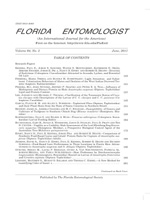Several genera in the Tubulifera are monotypic, and in some cases species were described based on a sole original holotype (Mound, 1976). This scenario complicates the study of morphological variation in species, and in several cases, intraspecific variation may be greater than variation between species (Retana-Salazar & Mound 1994). Reports of taxa from new localities and descriptions of specific character variation are fundamental in the study of these groups. Modest publications of this sort advance the construction of a more complete landscape of morphological variation on an interspecific and intraspecific level.
A new locality (Nayarit, Mexico) for two known species is reported in this paper. Comments about variations of characters are included.
Phlaeothripinae
Eurythrips Hinds 1902
Eurythrips is a New World genus, particularly common in the Neotropical region. The most recent revision of this genus placed in synonymy 16 of the 54 species included in this group (Mound 1976). The latest work concerning the thrips of Central and South America listed 37 species for this region (Mound & Marullo 1996). Several of these species are not well known and in some cases they are only known from the type material.
Eurythrips longilabris Watson
Eurythrips longilabris Watson 1921
Eurythrips harti Hood 1925
Material: Holotype female, USA, Florida State Collection of Arthropods (FSCA) and material from Texas (USNM) (Holotype of E. harti).
New Record. Collected on weeds, Santiago Ixcuintla County, Nayarit, México. 1 specimen.
Comments. Mound (1976), after of examination of the holotypes, considered both longilabris and harti species as synonymous; he considered that the morphological differences were not enough to consider these as two different species. Indeed, Mound (1976) showed that main differences are in color details and in the postocular setae. Each of these setae is acuminate in the longilabris holotype but softly pointed in the harti holotype. The color pattern of this specimen collected in Mexico is congruent with the most comprehensive key published to date (Mound, 1976). The postocular setae in the material collected in Mexico are similar to those of the longilabris holotype described by Mound (1976), that is to say, an acuminate shaped apex is present.
Idolothripinae
Ethirothrips Karny 1925
This is complex genus. Mound and Palmer (1983) considered 7 genera as synonyms of Ethirothrips. There are considerable differences between several species included in this genus. Mound and Marullo (1996) considered that some of these species are widely distributed and variable in color as well as in structure. Ethirothrips is a common member of the fauna of thrips associated with dead branches and leaf-litter in Brazil (Monteiro 2002).
Ethirothrips firmus Hood 1952
Material: Identified solely from a type series (5 specimens) collected in Sao Paulo, Brazil.
New Record. Collected on weeds, Santiago Country, Nayarit, Mexico. 1 specimen
Comments. Although described as a species of Gastrothrips, it is currently considered to be included in Ethirothrips. There are no reports of this species found anywhere else but at its original type locality. The structural variation in the species of this genus (Mound & Marullo 1996) presents a complex scenario for the study of this group. New material collected in México is congruent with all the morphological details described in the key presented by Mound and Marullo (1996). The presence of this species only in Brazil and Mexico suggests that Mound's hypothesis regarding distribution, related to human activity, holds true.
These two species have become identified through descriptions based on a single holotype, in the first case, and from a single type series in the second case. The new material presented allows new localities to be defined and the variability of morphological characters used in species definition to be explored further.





